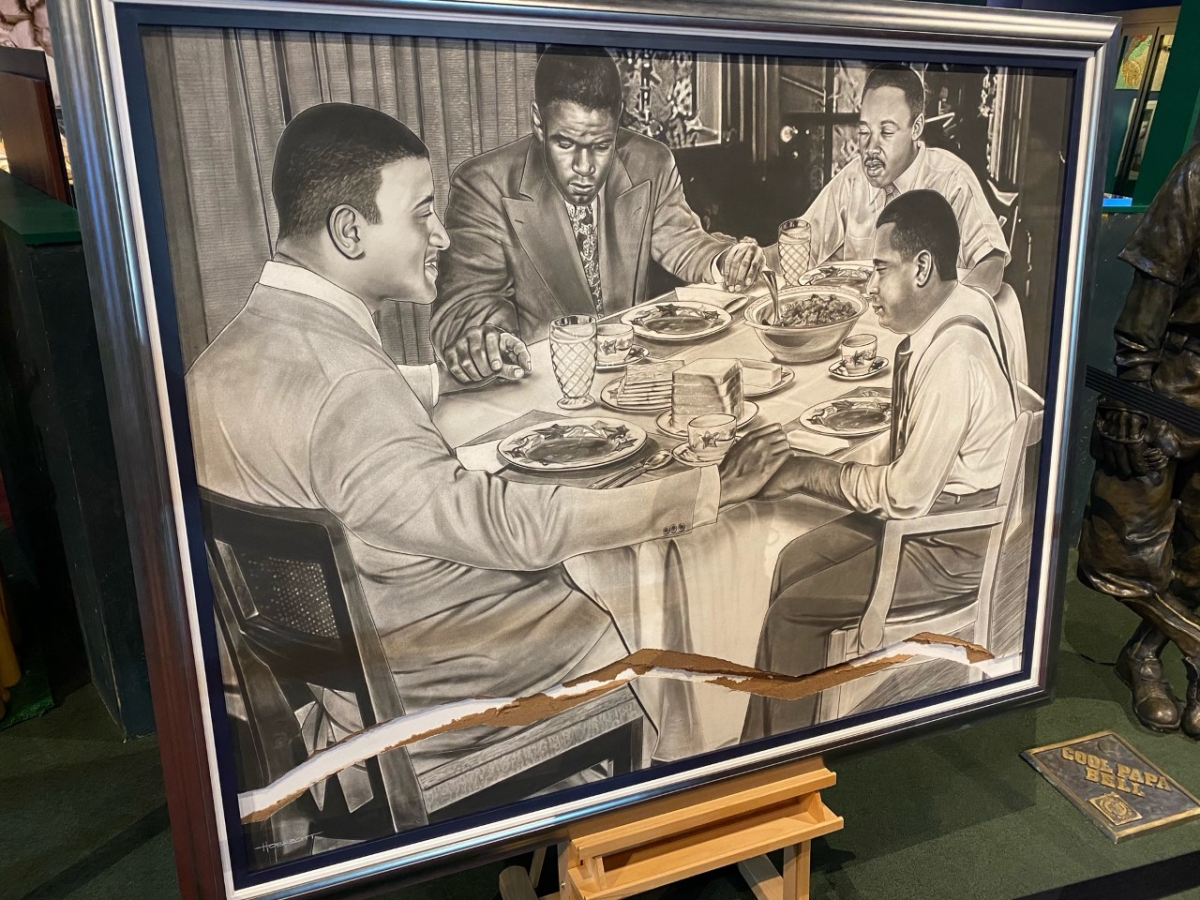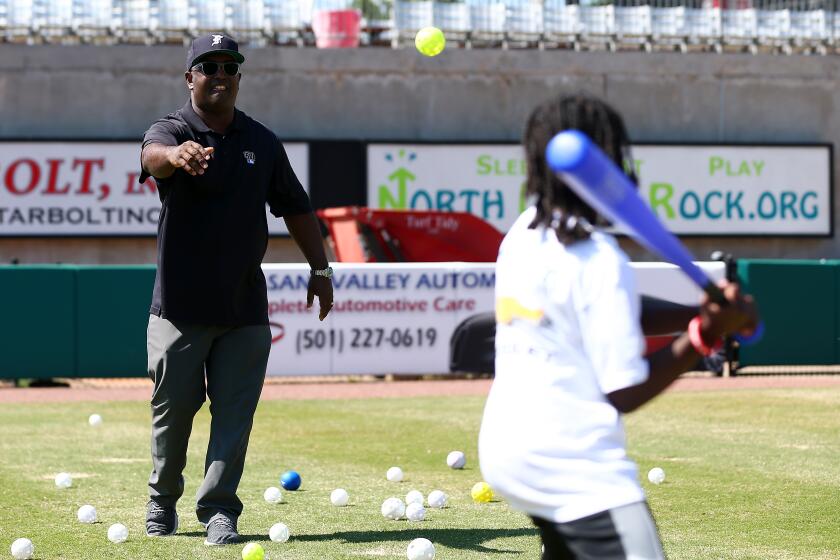How a broken painting captured Jackie Robinson’s unbreakable spirit

- Share via
KANSAS CITY — Bob Kendrick beamed with pride as he looked at the broken painting.
In black and gray strokes of charcoal and pastel, four men are depicted. They sit around a dinner table. Their hands are clasped together. Their heads are bowed as they say grace.
It’s a setting that played out several times in real life: Martin Luther King Jr. joining Dodgers legends Don Newcombe, Roy Campanella and Jackie Robinson for a meal, thanking them for their contributions to the civil rights movement as some of the first — and in Robinson’s case, the very first — baseball players to break MLB’s color barrier.
None of the actual meetings were ever captured in photos or video. But the stories of the dinners have become legend in baseball circles. Last year, a Laguna Beach-based sports artist named Dave Hobrecht decided to paint a recreation of the scene.
And on Thursday, in celebration of Jackie Robinson Day, the painting, entitled “Grace,” was unveiled at the Negro Leagues Baseball Museum.
Dodgers get three-run homers from Turner and Muncy and David Price gets the save in 7-5 win over Colorado
“It speaks to just how powerful a moment in time it was, when Jackie took the field,” said Kendrick, the museum president, as he showed it off to a visiting reporter.
“We’ve always made the assertion that Jackie’s breaking the color barrier wasn’t just a part of the civil rights movement — it was the beginning of the civil rights movement.”
There was only one problem. The wooden canvas had been wrecked during shipment, resulting in a crack that completely detached the bottom portion of the image from the rest.
“Damaged is probably an understatement,” Kendrick said. “It was almost destroyed.”
Most of Hobrecht’s paintings are completed in a couple weeks. But this one took seven months. Creating a new one was out of the question. But there weren’t many other appealing options either.
They thought about putting the pieces back together like a puzzle, but knew a crease would still be visible. They considered cropping the image above the crack, but worried it cut too much away.
So, they decided to do something else, something more symbolic. They reframed it, but with the two pieces purposely pulled apart several inches. No, the painting wouldn’t be flawless. But nothing about the story it represents is either.
“Not having a breakable spirit — that’s Jackie Robinson,” Kendrick said. “So yeah, the painting is broken, but you won’t break our spirit. We’ll just unveil it with this damage there. That will be this metaphor that I think beautifully captures what Jackie was all about.”
Most of the sports world knows the basics of Robinson’s story. How he became a star athlete at UCLA. How he was signed by Dodgers general manager Branch Rickey in 1945. How he broke MLB’s color barrier two years later on April 15, 1947. How his memory is now celebrated on that day each year, with every MLB player wearing his No. 42 for a game.
But Kendrick knows that doesn’t cover Robinson’s full story — his beginnings in the Negro Leagues, his efforts to battle racism and social inequality away from the field.
He was a “complicated” figure, Kendrick said, one whose political alliances didn’t always align with other civil rights leaders of the time. He didn’t support John F. Kennedy’s presidential campaign in 1960, troubled by what he viewed as Kennedy’s weak stance on civil rights. He initially refused to denounce the Vietnam War, too.
But he always acted authentically, never wavering from his ideas for social progress.
“He shouldered the weight of 21 million Black folks when he took the field,” Kendrick said.
That’s why, when Hobrecht first approached Kendrick about the painting of Robinson, King and the others last summer, he was immediately excited by the idea.
“For Dave to take that story, and transfer it into an artistic expression,” Kendrick said, “it gave us another opportunity to look at the civil rights aspect of Robinson’s career.”
An Orange County native who has followed both Southland MLB teams throughout his life, Hobrecht was initially inspired while working on a not-yet-released book project with former Dodgers general manager Ned Colletti about all-time great Dodgers players. At one point, Colletti relayed Newcombe’s stories about the dinners with King. Hobrecht was floored.
Former Angels GM and self-described ‘Boys Club kid’ Tony Reagins is committed to ‘real programs with real young people that have real impact.’
“[Colletti] told me they would share a meal and talk about baseball and segregation and racism,” Hobrecht said. “I go, ‘Ned, that’s a crazy story.’ ”
Hobrecht researched every detail: What they might have been wearing (suits, mostly, and in King’s case, a short-sleeve shirt underneath); what food they might have been served (soup, bread, crackers); even the type of tableware common for that 1950s era.
He painted the moment they would have said grace, holding each others’ hands as King delivers a prayer.
It captured Robinson in a different setting, epitomizing his stature off the field.
That’s what the NLBM has focused its celebration of Robinson on this year, Kendrick said, conveying “his impact on the civil rights movement seemed to be a natural fit.”
And Kendrick and Hobrecht agree. The crack at the bottom of the painting only underlines the unbreakable spirit showcased within.
“It’s symbolism,” Hobrecht said. “These guys, you can’t break them. You could do whatever you want to them, but they were gonna still charge forward.”
More to Read
Are you a true-blue fan?
Get our Dodgers Dugout newsletter for insights, news and much more.
You may occasionally receive promotional content from the Los Angeles Times.









